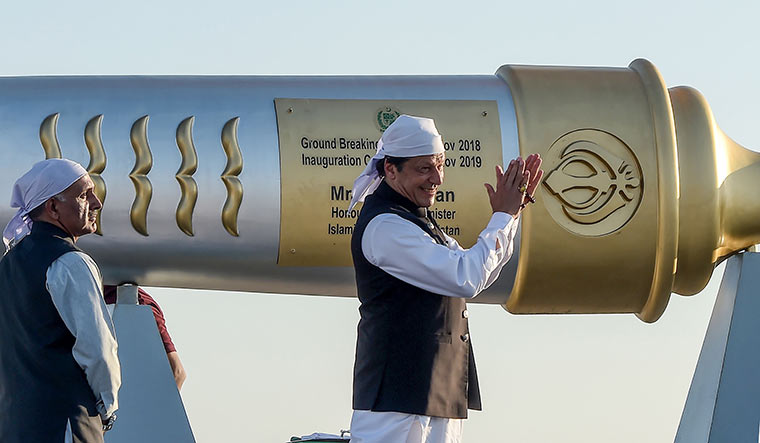IT IS SELFIE SEASON in Kartarpur, Pakistan, and everyone is afflicted. At Gurdwara Darbar Sahib, it is impossible to walk on the day of the opening of the Kartarpur corridor—linking the gurdwara with the Dera Baba Nanak shrine in India’s Gurdaspur district—without bumping into someone smiling brightly for the camera. Each step of the colossal complex is being captured by a sea of phone cameras.
Stopping to pose in front of the gate with her husband, Paramjit Kaur beams at her phone. “This is my third visit,” she said. “I came a few years ago, but this is just beautiful. I am so grateful.’’ She is not alone. Ranjit Kaur, a first-timer, is teary-eyed as she bends down to touch the floor. “I am so happy,” she said. “My mother spent her life desperate to see this gurdwara and now I am here.”
The Saturday (November 9) sky is clear. There are fervent prayers on everyone’s lips, and more than 3,000 hearts filled with gratitude. And, at a time when relations between the two neighbours are less than warm, the opening of the corridor is essential.
The transformation of Kartarpur has taken place in a record 11 months. Even Pakistan Prime Minister Imran Khan quipped: “I did not know my government was so efficient.” India, however, attributes the speed to the Army. The corridor project, as an official said, predated the civilian government. “He is just the face,’’ he said. In Pakistan, too, Army chief General Qamar Javed Bajwa’s interest is not a secret. The hug that sparked off the historic move was between Bajwa and Congress leader Navjot Singh Sidhu. He was also present at the foundation laying ceremony of the corridor in November 2018.
The tiny white gurdwara that once stood forlorn in the midst of fields has been converted into the biggest attraction in Pakistan. It is now the perfect model for the softer image Pakistan is trying to construct: a moderate country open to religious tourism. It is in line with Muhammad Ali Jinnah’s first speech to the Constituent Assembly of Pakistan—“... you are free to pray at your temples....”
“We have identified 400 temples,’’ said foreign minister S.M. Qureshi at the inauguration of the corridor. Punjab governor Chaudhry Mohammad Sarwar, too, said that they are going to promote Hindu tourism and focus on Buddhism. While it is a carefully crafted image, judging by the response Pakistan got, with ambassadors of various countries tweeting their selfies against the backdrop of the gurdwara, it seems that Khan has won the perception battle. For Pakistan, which is facing tough strictures from the Financial Action Task Force for terrorism, the Kartarpur gurdwara is essential to project a different image.
However, Kartarpur and its possibility were overshadowed by Kashmir. Khan, in his speech, asked for “justice for the people of Kashmir’’, as did Qureshi. But Prime Minister Narendra Modi chose to be statesmanlike and thanked Pakistan and the people who worked on the project. (India cleverly chose a Jathedar from the Akal Takht to speak officially. Sidhu, who thanked Khan warmly, was there on Pakistan’s invitation.)
Politics apart, Kartarpur corridor is an important “people-to-people’’ initiative between the two governments—one that goes beyond the territory of hope and sentimentality that they have chosen to undertake with “eyes wide open’’, as an Indian official put it. The reason? Sikh sentiment, in India and the diaspora.
The corridor agreement has been the only piece of business that the two nations have done despite the Pulwama attack and Pakistan’s cutting off ties and increased rhetoric on Kashmir post the removal of Article 370. The talks on the corridor, oddly, have been insulated in a protective bubble. Even the agreement on the modalities of the pilgrims—which was not easy to work out—was finally completed. “The Indian side has negotiated a good agreement,’’ said former high commissioner to Pakistan G. Parthasarathy.
Security concerns loom large, especially with the Khalistan referendum next year. “Over the past decades, several Pakistan governments, led by the army, have set themselves an objective of creating a Hindu and Sikh divide in India,’’ said Parthasarathy. “I have personally seen anti-Indian slogans in gurdwaras in Pakistan.’’
But Khalistan and its idea may not take root in India; even suggesting the idea in Punjab is enough to get Sikhs enraged. “Does India actually believe that we are so weak that we will get indoctrinated in five hours,’’ asked Baljit Singh, who has travelled to Pakistan many times in jathas [group of pilgrims]. “Jathas travel to Pakistan four times a year for 15 days at a time, but no arms have come this way. Why do we have to prove our loyalty?’’ Just a day before the corridor was to open, there was an infiltration bid that was stopped. For devotees, however, the opening of the corridor is a prayer that has been answered. But they are practical. “Everyone thinks that we are safe till Gurpurab,” said Mejindarpal Kaur from Malaysia, who spent six hours to book her place online the day the website was up. “Everyone wants a date just after that for a week or so. They don’t think it will last.”
But does the corridor offer hope? It certainly is testimony to the sheer power of people-to-people connect. But now, when talks are not on the agenda, the spirit of Kartarpur will need a miracle to become stronger.


